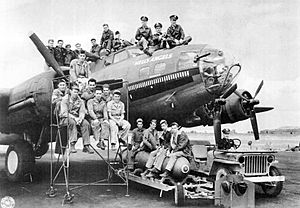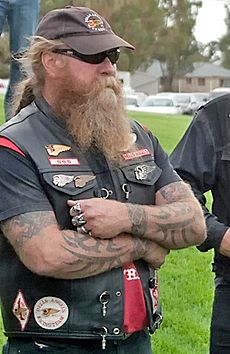Hells Angels facts for kids
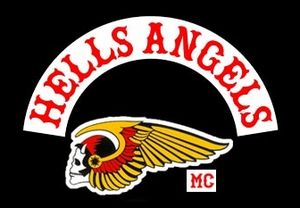 |
|
| Abbreviation |
|
|---|---|
| Founded | March 17, 1948 |
| Founder | Otto Friedli |
| Founded at | Fontana, California, U.S. |
| Type | Outlaw motorcycle club |
| Headquarters | Oakland, California, U.S. |
|
Region
|
Worldwide (592 charters in 66 countries) |
|
Membership
|
6,000 |
|
Key people
|
Sonny Barger |
The Hells Angels Motorcycle Club (HAMC) is a well-known international motorcycle club. Its members usually ride Harley-Davidson motorcycles. In the United States and Canada, the club is officially known as the Hells Angels Motorcycle Corporation.
People often call the club "H.A.", "Red & White", or "81". It is one of the largest motorcycle clubs in the world. It has over 6,000 members and 592 local groups, called "charters", in 66 countries.
Contents
History of the Hells Angels
The Hells Angels started on March 17, 1948, in Fontana, California. Several smaller motorcycle clubs decided to join together. Otto Friedli, who was a veteran from World War II, is often given credit for starting the club. He had left another motorcycle club after a disagreement.
Another idea is that the Hells Angels began on November 15, 1951, in San Bernardino, California. This was started by Dick White, who was part of the Redlands Road Runners.
How the Name "Hells Angels" Started
The club's website says that the name was suggested by Arvid Olsen. He was a friend of the founders and had served in a "Hell's Angels" squadron. This squadron was part of the Flying Tigers during World War II in China.
Another idea is that the name came from a "Hell's Angels" squadron. This squadron was part of the 303rd Bombardment Group in Europe during World War II. It seems the name was inspired by a tradition from World War I and II. American squadrons often chose strong, brave names.
For example, one of the P-40 squadrons of the Flying Tigers was called "Hell's Angels". In 1930, a film by Howard Hughes called Hell's Angels showed amazing and risky flying. Many believe that World War II groups used this name because of the movie. The Hells Angels' website notes that the apostrophe is missing in "Hells". They say, "it is you who miss it. We don't."
Early Club Growth
Some of the early history of the Hells Angels is not fully clear. Different stories exist about how it grew. The club's first official charter was reportedly set up in Fontana in 1950.
Many independent Hells Angels charters were formed across California. This happened in the years after the club started. Members who traveled from city to city helped create these new groups. The San Francisco ("Frisco") charter was reportedly started in 1954. Its members were from a group called the Market Street Commandos.
A North Sacramento charter began in 1956. Then, another charter in Sacramento formed in 1957. This one was started by two brothers, James "Mother" Miles and Pat Miles. They were from the Hell Bent for Glory biker club. The Sacramento charter later moved to Richmond in 1965. It became a Nomads chapter.
Ralph "Sonny" Barger started the Oakland charter in 1957. He said other early charters were in Gardena and other places. Often, members did not know about other clubs. Barger is known for helping to unite these different groups. He brought them together under common club rules.
Other sources say the San Francisco Hells Angels were organized in 1953. This was done by Rocky Graves, a Hells Angel from San Bernardino. This suggests the "Frisco" Hells Angels knew about the earlier groups. The "Frisco" Hells Angels were reorganized in 1955. They had 13 founding members, with Frank Sadilek as president. They used a smaller, original logo.
The Oakland charter, led by Barger, used a larger "Death's Head" patch. It was called the "Barger Larger" and first appeared in 1959. This patch later became the standard for the whole club. The first charter outside California opened in Auckland, New Zealand, in 1961.
Hells Angels and Culture
The Hells Angels are sometimes seen in a romantic way, like old-time gangs. They are shown as free-spirited, loyal, and like a close family. Other times, like in the 1966 film The Wild Angels, they are shown as tough and rebellious.
The club became well-known during the 1960s counterculture movement. This was in San Francisco's Haight-Ashbury District. They were part of many important events of that time. Members were connected to many leaders of the counterculture. These included Ken Kesey, Allen Ginsberg, Jerry Garcia of the Grateful Dead, and Timothy Leary.
Journalist Hunter S. Thompson wrote a book about the club. This book helped start his career. From 1968 to 1969, the Hells Angels' San Francisco headquarters was at 715 Ashbury. This was across from the Grateful Dead house.
In 1973, members from different parts of the club protested. They went to an Environmental Protection Agency meeting. The meeting was about a plan that would limit motorcycle use and sales. This was to help California meet new air quality rules.
Club Symbols and Patches
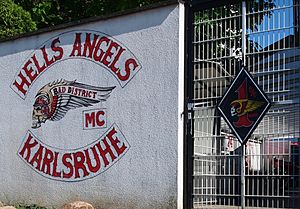
The Hells Angels' official website says Frank Sadilek designed the "death's head" symbol. He was a past president of the San Francisco charter. The colors and shape of the early jacket emblem were copied from military symbols. These came from the 85th Fighter Squadron and the 552nd Medium Bomber Squadron.
The Hells Angels use a system of patches. These are like military medals. The exact meaning of each patch is not fully public. But the patches show a biker's specific actions or beliefs. The official colors of the Hells Angels are red letters on a white background. This is why the club is called "The Red and White". Members wear these patches on leather or denim jackets and vests.
Red and white are also used for the number 81 on many patches. Examples include "Support 81" or "Route 81". The 8 stands for 'H' and the 1 stands for 'A' in the alphabet. Friends and supporters of the club use these. This is because club rules limit who can wear Hells Angels images.
The diamond-shaped one-percenter patch is also used. It shows "1%" in red on a white background. The term "one-percenter" is said to come from a comment by the American Motorcyclist Association (AMA). After an event, the AMA supposedly said that 99% of motorcyclists follow rules. They said 1% were not. The AMA says they have no record of such a statement.
Most members wear a rectangular patch. It has a white background with red letters. This patch shows their local charter's name. Another similar patch says "Hells Angels".
If a member holds a position in the club, they wear a patch for it. This patch is also rectangular with red letters on white. Examples of titles are President, Vice President, Secretary, Treasurer, and Sergeant at Arms. This patch is usually worn above the charter location patch. Some members also wear an "AFFA" patch. This means "Angels Forever; Forever Angels". It shows their lifelong commitment to the club.
The club's traditional saying is "Angels Forever, Forever Angels". Other Hells Angels sayings include: "When we do right, nobody remembers. When we do wrong, nobody forgets." Also, "Three can keep a secret if two are dead." And "When in doubt, knock 'em out," which was created by Vincent "Big Vinny" Girolamo.
Protecting Their Name and Symbols
The Hells Angels officially registered their club in 1966. They also trademarked the club's name and four main symbols. They first filed a lawsuit about trademark use on October 26, 1989. This was against a film company that made a movie called Nam Angels. The lawsuit was settled outside of court.
The Hells Angels also thought about stopping a TV show called The Last Chapter from being shown. This was because the biker group in the show looked very much like the Hells Angels.
In March 2007, the Hells Angels sued Walt Disney Motion Pictures Group. They said Disney's film Wild Hogs used their name and logo without permission. The lawsuit was later dropped after Disney promised to remove the references.
On October 7, 2009, the Hells Angels' lawyer contacted an online gaming community. He asked them to remove club symbols from a game forum. The lawyer later confirmed his identity on social media.
In October 2010, the Hells Angels sued Alexander McQueen. They said the fashion brand used their "winged death heads symbol" on clothing. The lawsuit also included stores that sold these items. The club's lawyer said, "This isn't just about money, it's about membership." The company settled the case. They agreed to remove all items with the logo from sale.
In 2012, the Hells Angels sued Toys "R" Us and a yo-yo company. They said the yo-yos had their "Death Head" logo. The Hells Angels believed people would think the toys came from them. The case was settled, and the lawsuit was dismissed.
As of December 2013, the Hells Angels sell their official merchandise. They have a retail store in Toronto, Ontario.
In 2019, the Hells Angels sued Redbubble in Australia for using their trademark. They sued again in 2021 when Redbubble continued to use it. In the first case, the Hells Angels won $5,000. In July 2022, Redbubble was ordered to pay the club over $78,000.
Becoming a Member
To become a Hells Angels "prospect," a person needs a valid driver's license. They also need a motorcycle larger than 750cc. They must also have "the right combination of personal qualities." The club is said to not allow people who have applied to be police or prison officers. Members in North America must ride U.S.-made motorcycles. Harley-Davidson bikes are most common. Other American brands like Victory and Indian are also allowed.
Steps to Join
Becoming a member is a long process with several steps.
- Hang-around: First, a person might be invited to some club events. They might meet members at known gathering places.
- Associate: If they are interested, they might become an "associate." This step usually lasts one or two years.
- Prospect: After that, they become a "prospect." They take part in some club activities. But they cannot vote yet. The club watches them to see if they are a good fit.
- Full Member: The final step is becoming a "full-patch" member. This means they get to wear the complete four-piece club symbol. This includes the "Death Head" logo, two patches called "rockers," and an "MC" patch. Prospects can only wear a bottom rocker with their location and the "MC" patch.
To become a full member, all current full members must agree. Before voting, a "prospect" usually visits every local group in their area. They introduce themselves to every "full-patch" member. This helps everyone get to know the prospect. Then, there is a formal ceremony. The "prospect" promises loyalty to the club. The final "Hells Angels" patch is given at this ceremony. This step is called "being patched."
Even after becoming a full member, the patches belong to the HAMC. If a member leaves or is asked to leave, they must return their patches. Members also pay dues. They must attend required club meetings and motorcycle rides. Club meetings are called "church." They are usually held at clubhouses or a member's home. In 1978, members paid $20 a month to their local group. They also paid $10 a month to the state group. This money helps pay for rides, funerals, and travel for club leaders. After being a member for a long time, some Hells Angels might not have to pay dues.
Membership Policies
The club does not officially have rules about race. However, in the United States, at least one group reportedly requires members to be white males. Sonny Barger said in a 2000 interview that the club as a whole is not racist. But he added that there might be enough racist members that a black person would not join. At that time, the club had no black members.
In another interview in 2000, Barger said that white motorcycle riders often want to join the Hells Angels. He said black riders often join other clubs like the Dragons. He said, "We don't have no blacks and they don't have no whites." When asked if this could change, Barger said, "Anything can change. I can't predict the future." Tobie Levingston, who started the East Bay Dragons MC, wrote that he and Barger are good friends. He said the Hells Angels and Dragons are also friends and ride together.
An article in Ebony in 1966 talked about black motorcycle clubs. The Chosen Few Motorcycle Club said they saw no racial issues with the Hells Angels. They said when Hells Angels came to their area, they would all party together. A Hells Angel member in the article said there was no racial bias in their clubs. He said they had no black members but that none had tried to join. In the 1970s, the Hells Angels offered every member of the Chosen Few a Hells Angels patch. This offer was turned down.
Some non-white members have been noted in the U.S. and other countries. In 1967, Hunter S. Thompson mentioned a "Chinese Mel" and a "young Negro from Oakland". Steven Wayne Yee, a Chinese-American member, was found guilty of a crime in 1990. The Satan's Angels MC in Vancouver had a black member when it joined the Hells Angels in 1983. The San Francisco and Anchorage groups were upset about this. But the issue was resolved when the man changed his nationality to "Hawaiian".
How the Club is Organized
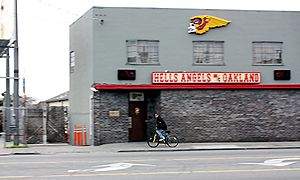
The Hells Angels were the first organized motorcycle club of their kind. Other biker clubs that formed later have copied their symbols, rules, and ways of doing things. Hells Angels charters are run by a group of officers. These include a president, vice president, secretary/treasurer, sergeant-at-arms, and road captain. Each charter must have at least six members. On average, they have between ten and twelve members. Each charter can make its own decisions about member rules and small policy changes.
Unlike some other big motorcycle clubs in the United States, the Hells Angels do not have one national or international president. Instead, they are led by regional officers. These officers are chosen to represent local charters at monthly regional meetings. Regional officers are split into two groups. One group attends the West Coast Officers Meeting ("WesCOM"). They handle policies for Hells Angels charters in the Western United States. The other group attends the East Coast Officers Meeting ("ECOM"). They manage charters in the Eastern United States. The dividing line between east and west is Omaha, Nebraska. In states with many charters, weekly state meetings are also held.
The Hells Angels do not have an official "mother charter." But the club's main unofficial headquarters was in San Bernardino, California. This was its founding location. It moved to Oakland, California in 1958. This happened after the club's founder, Otto Friedli, was imprisoned. Sonny Barger then became the unofficial national president. The Oakland charter has always been very important. It has the most members in the United States. Also, Barger is highly respected by members worldwide. The Oakland charter makes big decisions for the club. It also approves new charters. Any motorcycle club wanting to join the Hells Angels must apply to the Oakland charter. The Oakland Hells Angels must watch and approve the applicant club before it can join.
In New York state, the HAMC is registered as the Church of Angels. This is a nonprofit religious organization.
Hells Angels Around the World
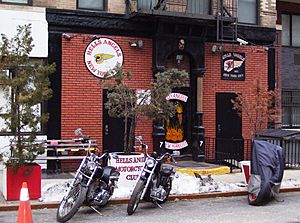
The HAMC has over 100 charters in more than 29 countries. New Zealand was the first country outside the United States to have a Hells Angels charter. The club started a group in Auckland in 1961. They have since taken over other groups in Whanganui.
The Hells Angels did not become widespread in Europe until 1969. That year, two London charters were formed. The Beatles' George Harrison invited some Hells Angels from San Francisco to stay at Apple Records in London in 1968. Only two members, Frisco Pete and Bill "Sweet William" Fritsch, reportedly showed up. Two people from London visited California, learned about the club, and joined. Two charters were officially started on July 30, 1969. One was for "South London" and the other for "East London." By 1973, these two charters combined into one, called "London." The London Angels helped with security at some music festivals in the UK.
In 1977, the Hells Angels came to Canada. The Popeye Moto Club joined them to form the Hells Angels' Montreal charter. During the 1980s and 1990s, the club grew a lot in the rest of Canada.
A list of recognized charters can be found on the HAMC's official website.
Support Clubs
Hells Angels groups often oversee smaller motorcycle clubs in their area. These are called support clubs or "puppet" clubs. These clubs can be a way for the Hells Angels to find new members. They also help the Hells Angels expand their presence in new areas. Support clubs might be formed just to help the Hells Angels. Or they might start as independent clubs and then come under Hells Angels' influence. These clubs might work with the Hells Angels for protection or to improve their own reputation. Members of support clubs attend Hells Angels events. They also spend time with Hells Angels at gatherings. Support club members can wear a diamond-shaped "81" patch on their vests. This shows their connection to the Hells Angels.
The Red Devils Motorcycle Club is the official and most well-known support club of the Hells Angels. It has groups in nearly 20 countries. The Hells Angels have more than two dozen support clubs in Canada. In Norway, the Hells Angels have created a network of support clubs. They control these clubs and are responsible for their patches. The Hells Angels have also formed support groups like AK81 in Denmark. Another is the Red & White Crew in Sweden. These groups are made up of young males who do not own motorcycles.
Club Mergers
Over the years, the Hells Angels have joined with many smaller motorcycle clubs. This process is called a "patch-over."
| Year | Location | Original Club/Charter | Hells Angels Charter |
|---|---|---|---|
| 1967 | United States | Animals MC Gooses MC |
Hells Angels Cleveland |
| 1969 | Aliens MC Nomads | Hells Angels New York City | |
| Hackers MC | Hells Angels Rochester | ||
| 1973 | Germany | Bloody Devils MC | Hells Angels Hamburg |
| United States | Storm Troopers MC | Hells Angels Durham | |
| 1975 | Grateful Dead MC | Hells Angels Bridgeport | |
| 1976 | Tribulators MC | Hells Angels Charleston | |
| 1977 | Canada | Popeye MC | Hells Angels North (Montreal) |
| 1978 | United States | Satan's Slaves MC | Hells Angels San Fernando Valley |
| Tar Heel Stompers MC | Hells Angels Charlotte | ||
| Netherlands | Kreidler Ploeg Oost | Hells Angels Amsterdam | |
| 1979 | United States | Original Jokers MC | Hells Angels Winston-Salem |
| 1980 | Netherlands | Mad Dogs | Hells Angels Haarlem |
| Denmark | Unionen MC | Hells Angels Copenhagen | |
| 1982 | Spain | Hells Angels Spain | |
| 1982 | United States | Grim Reapers MC Minneapolis | Hells Angels Minneapolis |
| Brothers MC | Hells Angels Anchorage | ||
| 1983 | Canada | Satan's Angels MC | Hells Angels Vancouver |
| 1984 | 13th Tribe MC | Hells Angels Halifax | |
| Gitans MC | Hells Angels Sherbrooke | ||
| 1985 | Denmark | Black Sheep MC | Hells Angels South (Helsingør) |
| 1990 | Germany | Phoenix MC | Hells Angels Berlin |
| 1991 | Canada | Satan's Guard MC | Hells Angels Trois-Rivières |
| 1992 | Norway | Rowdies MC | Hells Angels Trondheim |
| Denmark | Nordstjernen MC | Hells Angels Aarhus | |
| 1993 | Sweden | Dirty Dräggels | Hells Angels Malmö |
| 1994 | United States | Hell's Henchmen MC | Hells Angels Illinois Hells Angels Indiana |
| 1996 | Sweden | Rebels MC | Hells Angels Helsingborg |
| Finland | Overkill MC | Hells Angels Helsinki | |
| Denmark | Mental Midgets MC | Hells Angels Odense | |
| Norway | Customizers MC | Hells Angels Oslo | |
| The Shabby Ones MC | Hells Angels Stavanger | ||
| Denmark | Avengers MC | Hells Angels Aalborg | |
| 1997 | Sweden | Choppers MC | Hells Angels Stockholm |
| Canada | Grim Reapers MC | Hells Angels Alberta | |
| United States | Dirty Dozen MC | Hells Angels Arizona | |
| 1998 | Canada | Rebels MC | Hells Angels Saskatoon |
| 1999 | Norway | Screwdrivers MC | Hells Angels Hamar |
| Sweden | Gamlestadens MC | Hells Angels Gothenburg | |
| 2000 | Canada | Los Bravos MC | Hells Angels Winnipeg |
| Last Chance MC Lobos MC Para-Dice Riders MC Satan's Choice MC |
Hells Angels Ontario | ||
| 2001 | Denmark | Piraterne MC | Hells Angels Randers |
| 2002 | United States | Brothers Fast MC | Hells Angels Denver |
| 2004 | Canada | Bandidos MC Edmonton | Hells Angels Red Deer Nomads |
| 2015 | United States | North Coast MC | Hells Angels Akron |
Images for kids
See also
 In Spanish: Hells Angels para niños
In Spanish: Hells Angels para niños
- List of outlaw motorcycle clubs


